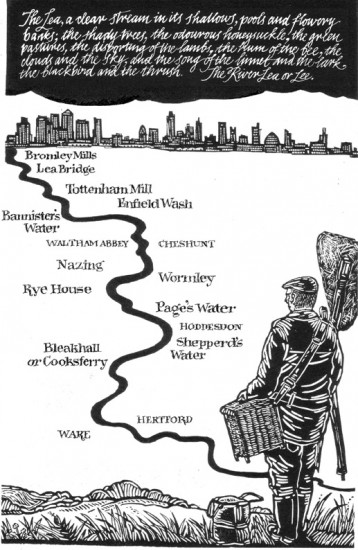
illustration by John Richardson.
by Luke Turner.
Part One.
Perhaps the part of Caught By The River’s Collection Of Words On Water that most caught my imagination was the extract that told of the hundreds of men who, every Sunday, would mumble excuses to both spouse and the Lord, and eschew church in favour of fishing on the reaches of the Lea that flow through north east London, via Tottenham and Hackney. I’ve lived in that area for the past ten years, and have spent many weekend afternoons walking along the Lea Navigation, enjoying one of London’s few big horizons, and watching men passing balls and bloodied noses on what was Hackney marsh, but it never occurred to me that there any fish still in what looked like a stagnant trench. These, I thought, were dead waters, and anyway, it was years since I had fished properly, and even as a boy, it was an infrequently practiced pursuit, consisting of outings in the River Severn on family holidays, or the occasional trip to local gravel pits, where I caught a frisby and a bream.
A collection of old maps that I have on the wall of my flat on Rowhill Road, E5, reveal that this was once the edge of London. 19th century development creeps not street by street but block by block across the fields and stops, abruptly, at the water. On the other side of the map and marsh, huge railway yards appear. A sewage works, now a nature reserve, grew across the top. It wasn’t hard to see why the fish were gone, even if the oldest of the maps suggests this was a marsh of the sort that feeds imaginations, all sucking bog, mysterious mists, the Lea Bridge Road striking across it in a hurry to reach the other side.
But reading that chapter in Words on Water made me think that, though the industries that once filled the Lea Valley had for a while emptied it of life, surely they were cleansed, and something must have returned. Now, the back gardens of council houses reach down to the still, hardly-moving waters of the canal. To the south, the cranes heave glass and concrete into the Olympic site, while just behind the knackered fence that runs along the canal, squat one story changing rooms sit barred and covered in graffiti. It hardly looked auspicious. I had done my research about the state of fishing on the Navigation, but internet chatter seemed to die out in the middle of the last decade, good hauls by Lea Bridge Road wistfully remembered as a thing of the past. Blame was placed squarely on the twin evils of cormorants and Polish immigration, the former tangible, the latter an extension of tabloid paranoia. A reply to an email sent to those responsible for the water apologetically suggested that the cormorants were to blame, and that they were voracious enough to make attempts to restock the water rather futile.
Nevertheless, on one walk I had seen a dead fish, floating bloated and white in the scum on the near bank and, logic dictated, a dead fish meant live ones must be here, somewhere. One Saturday last year, I crossed what was once notorious as murder mile, through the streets of Lower Clapton, pass the old Hackney Power Station (now bisected so supports for a vanish roof give it the air of a ruined abbey) and sat quietly on the banks of the Lea Navigation. I groundbaited, and tried corn and bread and meat and waited. Patiently. For hours. For most of that first morning, nothing disturbed the water except a door, making its way slowly downstream to Bow Lock.
(to be continued….)